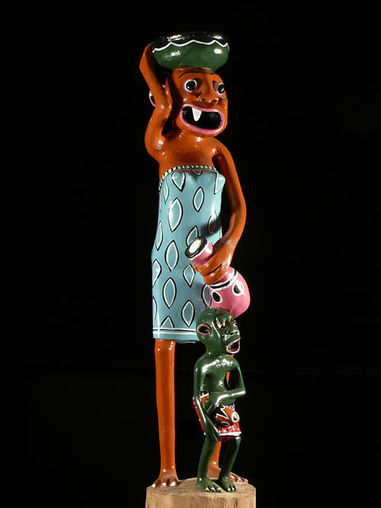Quite a few handicrafts are also produced in Tanzania. Batik cloth making is a common trade among women. Batik is made by stamping hot wax onto cloth in patterns and then dipping the cloth into a dye, which will adhere to all the places not covered in wax. Many of these batik designs use tribal or animal patterns. Woven mats and bowls are another common handicraft. Some use bright colors and incorporate designs into these. A lot of these items are sold at open air or roadside markets.
One of the more well-known styles of painting to emerge in the 20th century is Tingatinga painting, named after its creator, Edward Said Tingatinga. It typically uses bicycle paint since it holds up better and has brighter colors; masonite board seems to be the prefered material to paint on since it’s light but durable. Flowers, animals, and geometric designs seem to be the main themes. Many of these paintings have become known as “airport paintings” because of its appeal to tourists and its small size being easier to transport through airports. George Lilanga is quite known for his paintings using the tingatinga style, even though he never specifically studied it. He just hung around a bunch of these particular artists and picked it up from them (see why it’s good to pick good friends!).
 |
| George Lilanga with one of his tingatinga paintings |
 |
| George Lilanga is known for his shetani sculptures. Shetani are mythological spirits, mostly malevolent, and typically depicted as distorted animal or human figures. |
During the latter part of the 20th century, cartoon artists began to emerge as its own field. And they were widely popular. Some published their works in newspapers, and even political cartoons became a thing. Other artists created comic books and published them as a series.
| Cartoon by Salum Matata |
For the vast majority of Tanzania’s history, its literature has been primarily in oral traditions. Not only would they tell and pass along stories and folktales, but they also told poems, proverbs, and riddles. In recent years, the art of oral storytelling has fallen to the wayside a bit as family structure and modern society has impacted these traditions. However, written literature is still on the up and coming and still fairly undeveloped. A few writers have emerged in the field though, producing works in both Swahili and in English.
Some of the writers who write in Swahili include Shaaban Robert (novelist, essayist, poet; probably one of the most prominent Tanzanian writers), Muhammed Said Abdulla (known for his detective stories), Ebrahim Hussein (playwright, poet), and Fadhy Mtanga (creative writer, blogger).
There are also quite a few authors who write in English as well. Some of the top names include Peter Palangyo (novelist), Gabriel Ruhumbika (novelist, short story writer, translator), Marti Mollel (short story writer), and Abdulrazak Gurnah (novelist, nominated for the Booker Prize and Commonwealth Writers Prize).
Up next: music and dance




No comments:
Post a Comment